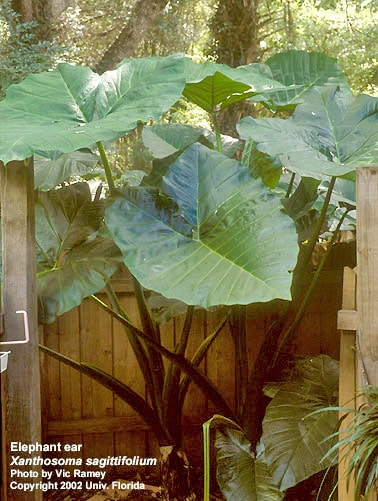QUESTION: I am new to Florida and this plant seems out of control in my yard. What is it? CM

JORDI: Welcome to Florida and more specifically, Nassau County. The plant you brought to the plant clinic is called an elephant ear, Xanthosoma sagittifolium. Elephant ear is on the Florida Noxious Weed list and is on the FLEPPC (Florida Exotic Plant Pest Council) Category II list. Therefore, you have my permission to remove it from your yard. At the very least, do not plant it by any body of water, including retention ponds.
Elephant ear is originally from Central and South American where the tubers are used in various meals. The tubers can be harvested and stored for several weeks if refrigerated.
Taro and elephant ear leaves are often mistaken for each other. The stalk or petiole attaching the leaf to the plant on the taro is several inches from the v-shaped base of the leaf. On the elephant ear, the attachment is directly at the base of the leaf. Taro leaves are dark green as opposed to a lighter green for the elephant ear. Taro leaves grow to about 4 feet in length whereas elephant ears can grow between 6-9 feet in length. If you want to get rid of the elephant ears, you will need to dig out the corms or rhizomes and throw them away in the trash.
Native IN – Invasive OUT
Remember, the UF/IFAS Nassau County Florida Master Gardener volunteers have a new program called Native IN – Invasive OUT. Send me a photo of the invasive plants in your yard, then show me a photo of their removal (rhizomes too) and we will give you 3-5 plants for replacement. Use [email protected] to send your photos and we will get you in the program. For more complete information on elephant ear consider reading about it from the FLEPPC list.
QUESTION: What is this on my viburnum? I don’t see tons of them, only one or two at a time, but they look interesting and I know how you love to see interesting things from the landscape. CR
JORDI: I have some photos of the same insect I found feeding on ornamental plants in local landscapes. These insects, called leafhoppers, have an interesting behavior.

Let me preface my next statement with: normally, I would not tell you to put your finger anywhere near an insect, but these insects do not bite us. If you put a stick or your finger near them, they will hide on the other side of the plant stem. You can chase them around the plant stalk – which I find a lot of fun. Now if teasing insects around a plant stalk is not amusing to you, then obviously I have no life!
Leafhoppers & Sharpshooters
Leafhoppers and sharpshooters are plant feeders with piercing/sucking mouth parts. They inject their sharp mouth part into the plant tissue and draw out vascular (xylem or phloem) fluid. The most troubling part of their feeding activity is the ability to transmit bacteria and viruses back to the plant.
Leafhoppers and sharpshooters belong to the family of the Cicadellidae, which is the 10th largest insect family. With their large eyes they easily detect predators and avoid them. In addition, they can detect the reflectance spectrum of several colors, with hues of yellow being the most attractive (Tipping et al. 2004). The natural enemies of the leafhopper include parasitic wasps and dragonflies.
For more complete information, consider reading the UF/IFAS publication titled: “Sharpshooters, Leafhoppers, Cicadellidae (Insecta: Hemiptera: Auchenorrhyncha: Cicadellidae)” by Chris Tipping and Russell F. Mizell III.
—————–
Rebecca L. Jordi
Nassau County Extension Director
UF/IFAS Environmental Horticulture
543350 U.S. Highway #1
Callahan, FL 32011
904-530-6351